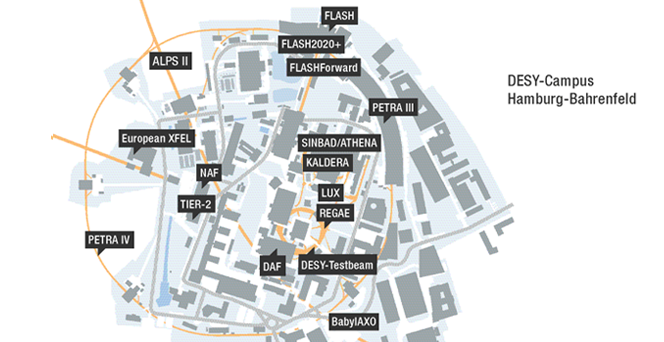URL: https://v1.desy.de/site_www-desy/content/research/facilities__projects/aufgabenuebersichtsplan_v1_20220131_eng.html/@@siteview
Breadcrumb Navigation
Research facilities

DESY is one of the world’s leading accelerator centres. The accelerators and detectors that DESY develops and builds are unique research tools. The facilities generate the world’s most intense X-ray light, accelerate particles to record energies and open new windows onto the universe. In addition, DESY scientists are involved in major international projects in particle and astroparticle physics.
Accelerators for photon science
-
PETRA III: DESY operates one of the brightest storage ring X-ray radiation sources in the world.
-
PETRA IV: The storage ring PETRA is to be expanded into the world’s most powerful synchrotron radiation source.
-
FLASH: The free-electron laser generates ultrashort-pulse X-ray laser light.
-
FLASH2020+: The upgrade project makes the FLASH free-electron laser even more flexible and powerful.
-
European XFEL: DESY is the main shareholder and operates the accelerator of Europe’s big X-ray laser.
Particle physics
-
LHC: The Large Hadron Collider at the CERN research centre near Geneva is the world’s most powerful accelerator.
-
Belle II: The experiment at the SuperKEKB accelerator in Japan is used for research with B mesons.
-
ALPS II: The experiment searches for extremely light particles.
-
BabyIAXO: The prototype for the International Axion Observatory (IAXO) will search for extremely light particles from the sun.
-
MADMAX: The experiment is intended to explore the dark matter in our galaxy.
-
LUXE: The experiment is designed to test the theory of quantum electrodynamics.
Astroparticle physics
-
H.E.S.S.: The observatory in Namibia explores cosmic gamma rays.
-
CTAO: The observatory will investigate high-energy gamma rays from space.
-
ULTRASAT: The satellite will observe space in ultraviolet light.
-
IceCube: The telescope at the South Pole is looking for cosmic neutrinos.
-
RNO-G: The observatory in Greenland is intended to detect high-energy neutrinos with radio antennas.
Accelerator R&D
-
FLASHForward: The electron bunches of FLASH are used to explore particle-driven plasma acceleration.
-
LUX: LUX is used to investigate and further develop laser-driven plasma acceleration.
-
KALDERA: The high-power laser will make plasma accelerators competitive.
-
SINBAD/ATHENA: SINBAD and ATHENA offer unique infrastructures for the development of novel accelerators.
-
ARES: ARES enables accelerator research and the development of autonomous accelerator procedures.
-
PITZ: The photoinjector test facility at DESY in Zeuthen is used to develop and optimise electron sources.
-
REGAE: The source of relativistic electron beams enables innovative experiments.
Other facilities
-
DESY test beam: Groups from all over the world use the DESY test beam to check detector components.
-
DAF: Complex components for the LHC detectors ATLAS and CMS are being built and tested in the Detector Assembly Facility.
-
IDAF: The Interdisciplinary Data and Analysis Facility offers extensive computing capacities for research at DESY.
-
Tier-2: As part of the IDAF, the grid infrastructure provides computing and storage systems for particle and astroparticle physics.
-
NAF: The National Analysis Facility within the IDAF is a powerful computing complex for particle physics.
-
Maxwell HPC: The high-performance computing system complements the IDAF’s facilities in particular for photon science and accelerator R&D.


